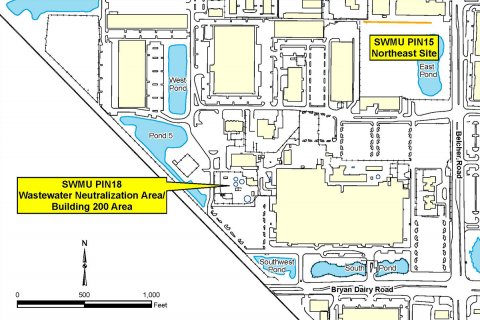In July 2016, the U.S. Department of Energy (DOE) Office of Legacy Management (LM) achieved two key cleanup milestones at the Pinellas County, Florida, Site in Largo by completing work at two of the site’s four active remediation areas where DOE has been performing corrective actions under a Hazardous and Solid Waste Amendments permit since 1990.
The Pinellas site is a former nuclear weapons component production facility 10 miles northwest of St. Petersburg that operated from 1957 to 1997. DOE has been remediating contaminated locations across the site for more than 25 years.
Contamination at the Northeast Site consisted of nonaqueous phase liquids, including trichloroethene, dichloroethene, methylene chloride, toluene, and oils. Cleanup involved using a large-diameter auger to remove contaminant source soils, and thermal treatment techniques including electrical resistive heating and steam-enhanced extraction to remove contaminant liquids and vapors that were treated in an above-ground treatment system. Following the excavation and extraction processes, enhanced bioremediation amendments were injected into the subsurface to treat the dissolved chlorinated solvents remaining in the groundwater. These actions resulted in removing more than 20,000 pounds of solvents and reduced contaminant concentrations to ear drinking-water standards.
Groundwater in the Wastewater Neutralization Area (WWNA) was contaminated with arsenic. DOE extracted the contaminated groundwater and conducted extensive soil sampling to identify the areas with the highest arsenic-contamination levels. These soils were excavated to remove the arsenic contamination source.
On July 27, the Florida Department of Environmental Protection (FDEP) issued conditional Site Rehabilitation Completion Orders for the Northeast Site and the WWNA. This milestone resulted from years of aggressive DOE efforts, using the most up-to-date technologies, to meet state groundwater cleanup target levels (drinking-water standards) and negotiate institutional controls with the landowners. The completion orders significantly reduce DOE’s long-term liabilities at the Pinellas site and document the state’s concurrence that remediation is complete and protective of human health. DOE has no additional remediation responsibilities at the two completed areas, no additional groundwater monitoring is required, and LM will assist the land owners in enforcing the minor groundwater use restrictions that make up the institutional controls.
DOE continues to conduct corrective actions at the two remaining active sites, the 4.5 Acre Site and the Building 100 Area, with the goal of achieving closures in the near future.
For more information about the Pinellas County, Florida, Site, please visit http://www.lm.doe.gov/pinellas/Sites.aspx.
| The electrical resistive heating and steam-enhanced extraction treatment system at the Northeast Site (above), and source soils excavation removed more than 20,000 pounds of solvents from groundwater and reduced contaminant concentrations to near drinking-water standards. |



